Design and Mechanical Properties Analysis of Variable Buffer-Force Planing Energy-Absorbing Device for Rail Vehicles
Abstract
1. Introduction
2. Experiments
2.1. Test Equipment
2.2. Preparation and Description of Test Specimen
2.3. The Simulation Model
3. Results and Discussion
3.1. Test Results
3.2. Simulation Results
4. Parametric Analysis
4.1. Influence Factors of Average Buffering Force
4.2. Influence of Dx on Material Properties
4.3. Influence of W on Material Properties
4.4. Influence of A on Material Properties
5. Conclusions
- A controllable buffering energy-absorbing structure whose buffering force can change with the stroke was proposed. The mechanical properties and deformation process of the material were studied by means of experiments and simulations. The influencing factors of the average force of the metal cutting buffer structure and its influence trend were described.
- The calculation formula of an average buffer force considering material strength and friction coefficient was obtained. As A increases, the average force of the material decreases gradually. When W increases, the average force of the material gradually increases, and when the width of the cutting material reaches a value, the average force does not change significantly. D can greatly affect the properties of the material.
- Through experiments, it was found that the buffer force of the structure will not change significantly due to the change of cutting speed. Finally, we obtained the significant degree of influence W > D2 > A. We fit the formula to obtain the average buffer force .
Supplementary Materials
Author Contributions
Funding
Institutional Review Board Statement
Informed Consent Statement
Data Availability Statement
Conflicts of Interest
References
- Yahia, H.; Yousuf, I.; Sheriyani, A.A. Implementing Specific Interventions to Reduce of Roads Traffic Accidents in Oman. In Proceedings of the International Traffic Safety Conference, Doha, Qatar, 26–27 November 2018. [Google Scholar]
- Noorsumar, G.; Rogovchenko, S.; Robbersmyr, K.G.; Vysochinskiy, D. Vehicle crashworthiness performance in frontal impact: Mathematical model using elastic pendulum. Mech. Res. Commun. 2022, 124, 103954. [Google Scholar] [CrossRef]
- Grotto, F.; Rivallant, S.; Bouvet, C. Development of a 3D finite element model at mesoscale for the crushing of unidirectional composites: Application to plates crushing. Compos. Struct. 2022, 287, 115346. [Google Scholar] [CrossRef]
- Zou, Q.; Zhou, X.; Wang, R.; Ning, Y.; Chen, Z.; Kong, F.; Liu, Y. Load-carrying and energy-absorbing performance of honeycombs with different cross sections under cyclic loading. Mat. Today Commun. 2022, 33, 104582. [Google Scholar] [CrossRef]
- Feng, Z.; Xie, S.; Ma, W.; Jing, K.; Wang, H. Multi-tube energy-absorbing structures with different matching patterns of heights and diaphragm spacings. Alex. Eng. J. 2022, 61, 11111–11127. [Google Scholar] [CrossRef]
- Isaac, C.W.; Ezekwem, C. A review of the crashworthiness performance of energy absorbing composite structure within the context of materials, manufacturing and maintenance for sustainability. Compos. Struct. 2021, 257, 1–32. [Google Scholar] [CrossRef]
- Peng, Y.; Deng, W.; Xu, P.; Yao, S. Study on the collision performance of a composite energy-absorbing structure for subway vehicles. Thin-Walled Struct. 2015, 94, 663–672. [Google Scholar] [CrossRef]
- Mansor, M.A.; Ahmad, Z.; Abdullah, M.R. Crashworthiness capability of thin-walled fibre metal laminate tubes under axial crushing. Eng. Struct. 2022, 252, 113660. [Google Scholar] [CrossRef]
- Liu, Y.; Qiu, X.M. A theoretical study of the expansion metal tubes. Int. J. Mech. Sci. 2016, 114, 157–165. [Google Scholar] [CrossRef]
- Abouridouane, M.; Bergs, T.; Schraknepper, D.; Wirtz, G. Friction behavior in metal cutting: Modeling and simulation. Procedia CIRP 2021, 102, 405–410. [Google Scholar] [CrossRef]
- Baroutaji, A.; Sajjia, M.; Olabi, A.G. On the crashworthiness performance of thin-walled energy absorbers: Recent advances and future developments. Thin-Walled Struct. 2017, 118, 137–163. [Google Scholar] [CrossRef]
- Wang, S.; Zhang, M.; Pei, W.; Yu, F.; Jiang, Y. Energy-absorbing mechanism and crashworthiness performance of thin-walled tubes diagonally filled with rib-reinforced foam blocks under axial crushing. Compos. Struct. 2022, 299, 116149. [Google Scholar] [CrossRef]
- Paz, J.; Costas, M.; Delgado, J.; Romera, L.; Díaz, J. Energy Absorption of Aluminium Extrusions Filled with Cellular Materials Under Axial Crushing: Study of the Interaction Effect. Appl. Sci. 2020, 10, 8510. [Google Scholar] [CrossRef]
- Yin, Z.; Shao, Z.; Qi, C.; Wu, H.; Wang, J.; Gao, L. Static Compressive Properties of Polypropylene Fiber Foam Concrete with Concave Hexagonal Unit Cell. Appl. Sci. 2023, 13, 132. [Google Scholar] [CrossRef]
- de la Rosa, Á.; Ruiz, G.; Poveda, E. Study of the Compression Behavior of Steel-Fiber Reinforced Concrete by Means of the Response Surface Methodology. Appl. Sci. 2019, 9, 5330. [Google Scholar] [CrossRef]
- Wang, Y.; Rong, R.; Liu, S.; Zhai, X.; Zhi, X. Energy absorption behaviour of an aluminium foam-filled circular-triangular nested tube energy absorber under impact loading. Structures 2021, 34, 95–104. [Google Scholar] [CrossRef]
- Yan, J.; Yao, S.; Xu, P.; Peng, Y.; Shao, H.; Zhao, S. Theoretical prediction and numerical studies of expanding circular tubes as energy absorbers. Int. J. Mech. Sci. 2016, 105, 206–214. [Google Scholar] [CrossRef]
- Chahardoli, S.; Alavi Nia, A.; Asadi, M. Parametric investigation of the mechanical behavior of expanding-folding absorbers and their implementation in sandwich panels core. Thin-Walled Struct. 2019, 137, 53–66. [Google Scholar] [CrossRef]
- Li, J.; Xie, Z.; Yu, Y.; Gong, X.; Gao, G. Experimental and numerical study on the crashworthiness performance of a hybrid energy absorber with expanding–splitting–bending process. Thin-Walled Struct. 2022, 181, 110122. [Google Scholar] [CrossRef]
- Salman, W.; Zhang, X.; Li, H.; Wu, X.; Li, N.; Azam, A.; Zhang, Z. A novel energy regenerative shock absorber for in-wheel motors in electric vehicles. Mech. Syst. Signal Process. 2022, 181, 109488. [Google Scholar] [CrossRef]
- Wierzbicki, T.; Recke, L.; Abramowicz, W.; Gholami, T.; Huang, J. Stress profiles in thin-walled prismatic columns subjected to crush loading-II. Bending. Comput. Struct. 1994, 51, 625–641. [Google Scholar] [CrossRef]
- Wu, F.; Liu, Z.; Guo, B.; Sun, Y.; Chen, J. Research on the burr-free interrupted cutting model of metals. J. Mater. Process. Technol. 2021, 295, 117190. [Google Scholar] [CrossRef]
- RDubey, R.; Jayaganthan, R.; Ruan, D.; Gupta, N.; Jones, N.; Velmurugan, R. Velmurugan, Energy absorption and dynamic behaviour of 6xxx series aluminium alloys: A review. Int. J. Impact Eng. 2023, 172, 104397. [Google Scholar]
- Magliaro, J.; Altenhof, W. Analytical predictions of the complete mechanical response of AA6061 energy absorbers subjected to axial cutting. Thin-Walled Struct. 2019, 139, 151–168. [Google Scholar] [CrossRef]
- Mahdavi, S.; Mahmoodi, A.; Pasandidehpoor, M.; Marzbanrad, J. Experimental and numerical investigation on cutting deformation energy absorption in circular tubes under axial impact loading by damage criterions. Thin-Walled Struct. 2017, 120, 269–281. [Google Scholar] [CrossRef]
- Hao, Y.; Wu, Y.; Ranjith, P.; Zhang, K.; Hao, G.; Teng, Y. A novel energy-absorbing rock bolt with high constant working resistance and long elongation: Principle and static pull-out test. Constr. Build. Mater. 2020, 243, 118231. [Google Scholar] [CrossRef]
- Xie, S.; Zhang, J.; Liu, X.; Zheng, S.; Liu, Z. A reinforced energy-absorbing structure formed by combining multiple aluminum foam-filled open-hole tubes. Int. J. Mech. Sci. 2022, 224, 107319. [Google Scholar] [CrossRef]
- Shen, X.; Zhang, D.; Yao, C.; Tan, L.; Li, X. Research on parameter identification of Johnson–Cook constitutive model for TC17 titanium alloy cutting simulation. Mater. Today Commun. 2022, 31, 103772. [Google Scholar] [CrossRef]
- Wang, J.; Lu, Z.; Zhong, M.; Wang, T.; Sun, C.; Li, H. Coupled thermal–structural analysis and multi-objective optimization of a cutting-type energy-absorbing structure for subway vehicles. Thin-Walled Struct. 2019, 141, 360–373. [Google Scholar] [CrossRef]
- Sharifzadeh, M.; Lou, J.; Crompton, B. Dynamic performance of energy-absorbing rockbolts based on laboratory test results. Part I: Evolution, deformation mechanisms, dynamic performance and classification. Tunn. Undergr. Space Technol. 2020, 105, 103510. [Google Scholar] [CrossRef]
- Li, W.; Fan, H.; Bian, Y.; Yang, F. Plastic deformation and energy absorption of polycrystalline-like lattice structures. Mater. Des. 2021, 198, 109321. [Google Scholar] [CrossRef]
- Zhang, H.; Peng, Y.; Hou, L.; Tian, G.; Li, Z. A hybrid multi-objective optimization approach for energy-absorbing structures in train collisions. Inf. Sci. 2019, 481, 491–506. [Google Scholar] [CrossRef]
- Yang, C.; Zhao, Z.; Guo, W.; Xu, P.; Zhou, S.; Yan, L.; Jin, X. Parametric beam-based crashworthiness optimisation for the crush zone of a subway vehicle. Thin-Walled Struct. 2023, 183, 110387. [Google Scholar] [CrossRef]
- Li, Q.Q.; Li, E.; Chen, T.; Wu, L.; Wang, G.; He, Z. Improve the frontal crashworthiness of vehicle through the design of front rail. Thin-Walled Struct. 2021, 162, 107588. [Google Scholar] [CrossRef]
- Mahmoud, Z.; Abbas, N.; Sima, Z. A novel method for enhancing energy absorption capability by thin-walled sections during the flattening process. Thin-Walled Struct. 2015, 97, 140–153. [Google Scholar]
- Meng, Y.; Zhang, Y.; Li, X.; Qi, Z.; Lin, Y. Cutting energy absorption property analysis and homogenization analysis of combined honeycomb subject to explosive loading. Thin-Walled Struct. 2022, 170, 108602. [Google Scholar] [CrossRef]
- Guan, W.; Gao, G.; Li, J.; Yu, Y. Crushing analysis and multi-objective optimization of a cutting aluminium tube absorber for railway vehicles under quasi-static loading. Thin-Walled Struct. 2018, 123, 395–408. [Google Scholar] [CrossRef]
- Schroeder, M.P. Developing CEM Design Standards to Improve Light Rail Vehicle Crashworthiness. In Proceedings of the ASME/IEEE 2006 Joint Rail Conference, Atlanta, GA, USA, 4–6 April 2006. [Google Scholar]
- Guo, Z.; Gao, B.; Guo, Z.; Zhang, W. Dynamic constitutive relation based on J-C model of Q235 steel. Explos. Shock Waves 2018, 38, 804–810. [Google Scholar]
- Wu, X.; Yu, H.; Guo, L.; Zhang, L.; Sun, X.; Chai, Z. Experimental and numerical investigation of static andfatigue behaviors of composites honeycomb sandwich structure. Compos. Struct. 2019, 213, 165–172. [Google Scholar] [CrossRef]
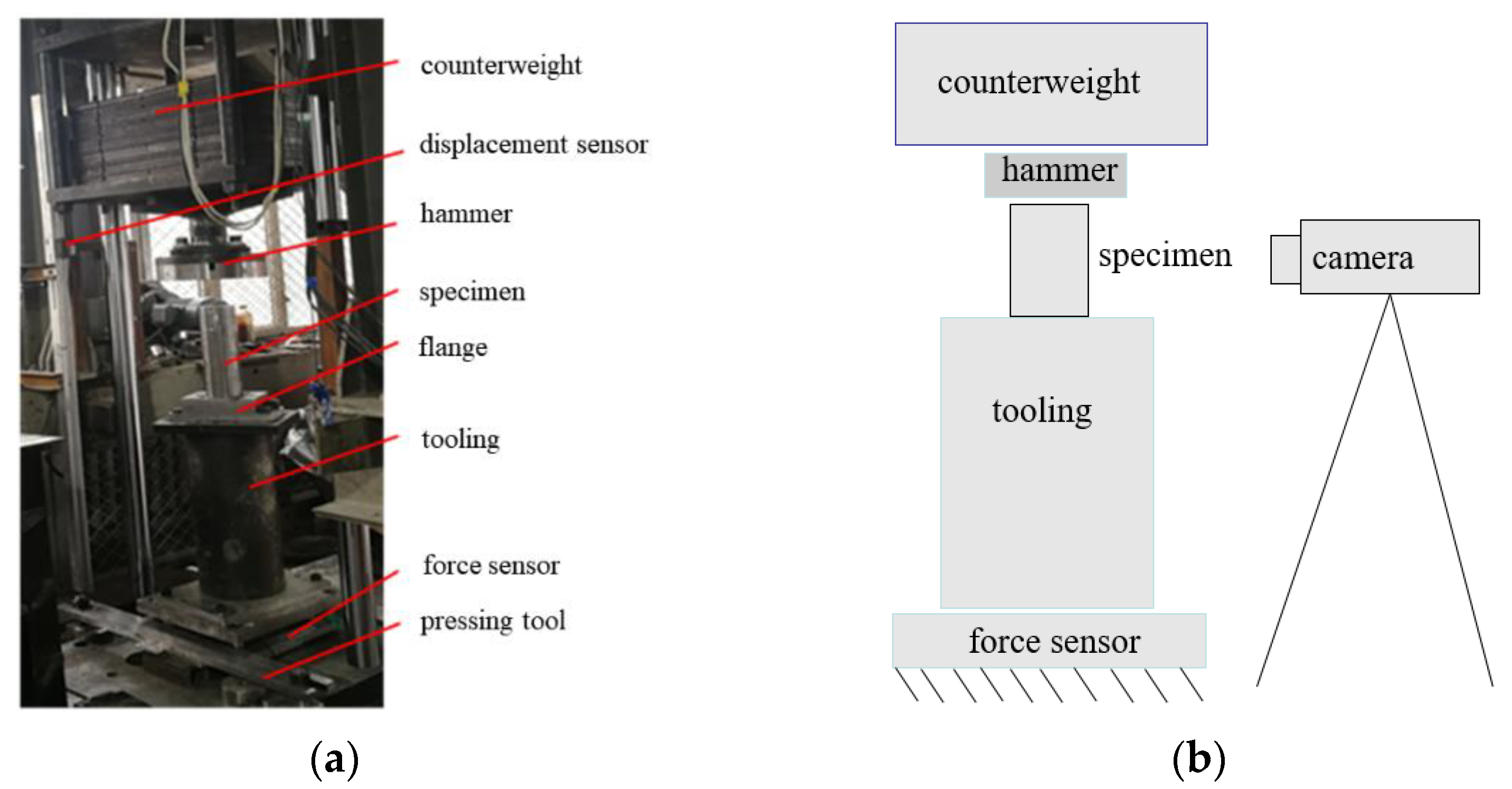
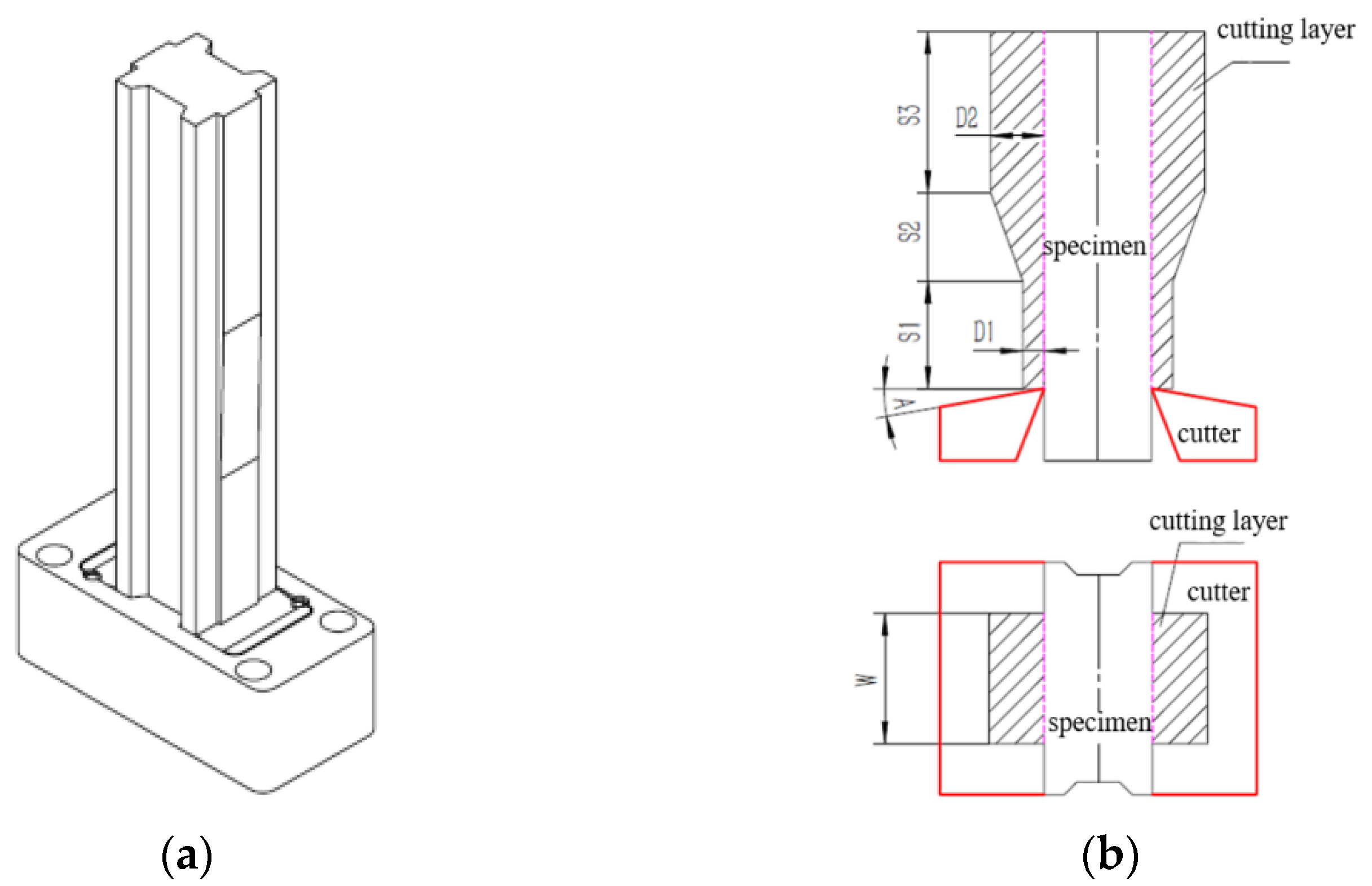
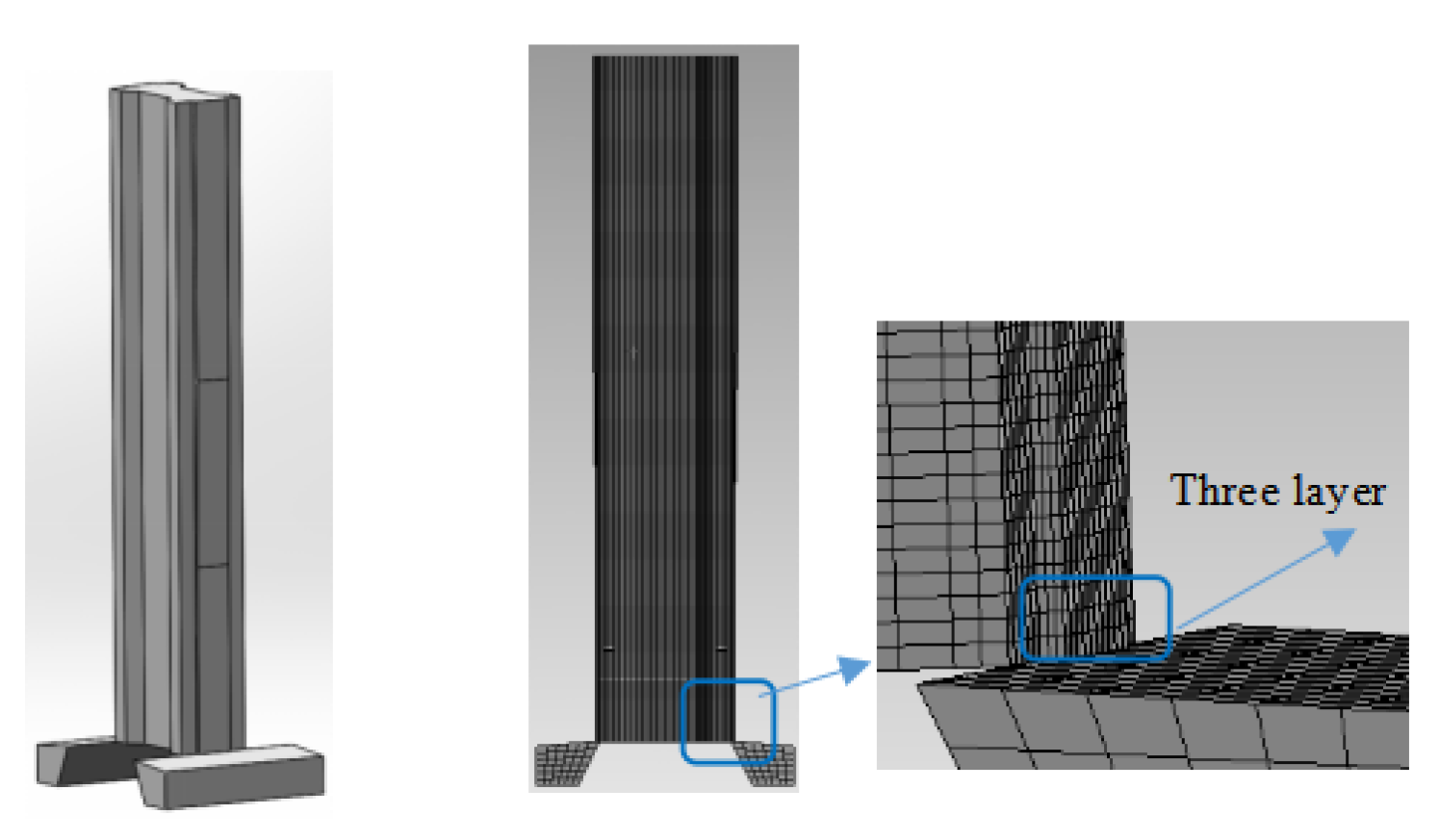

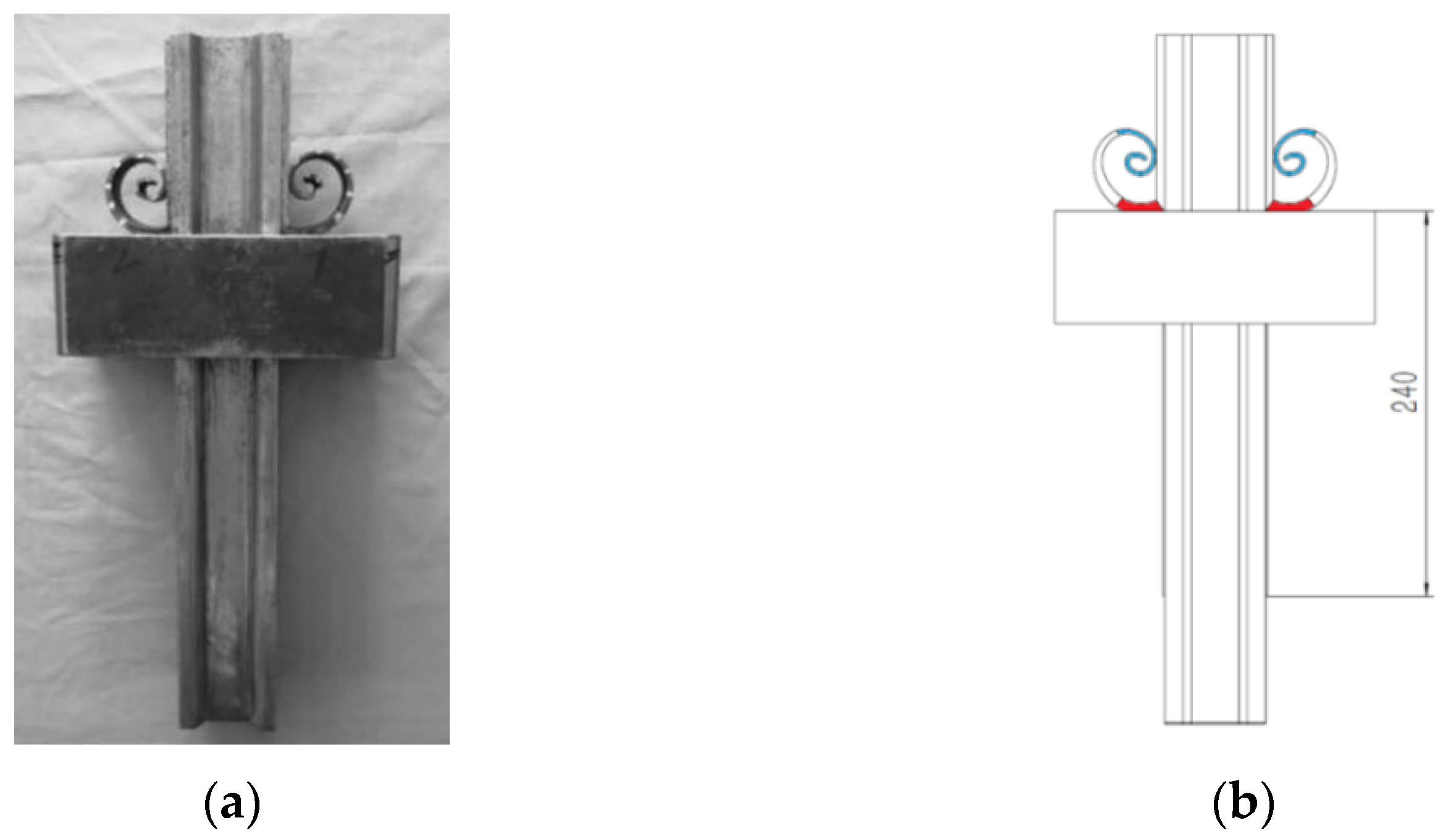
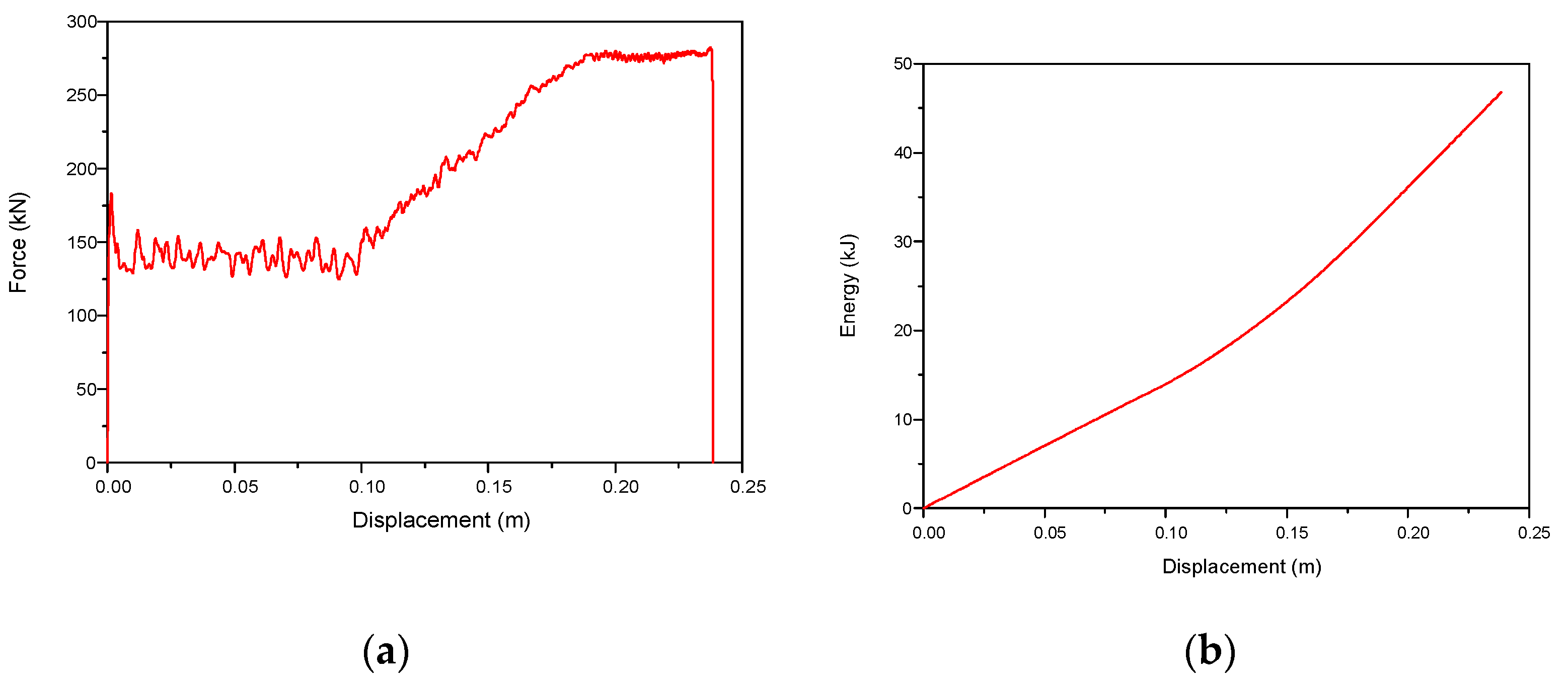
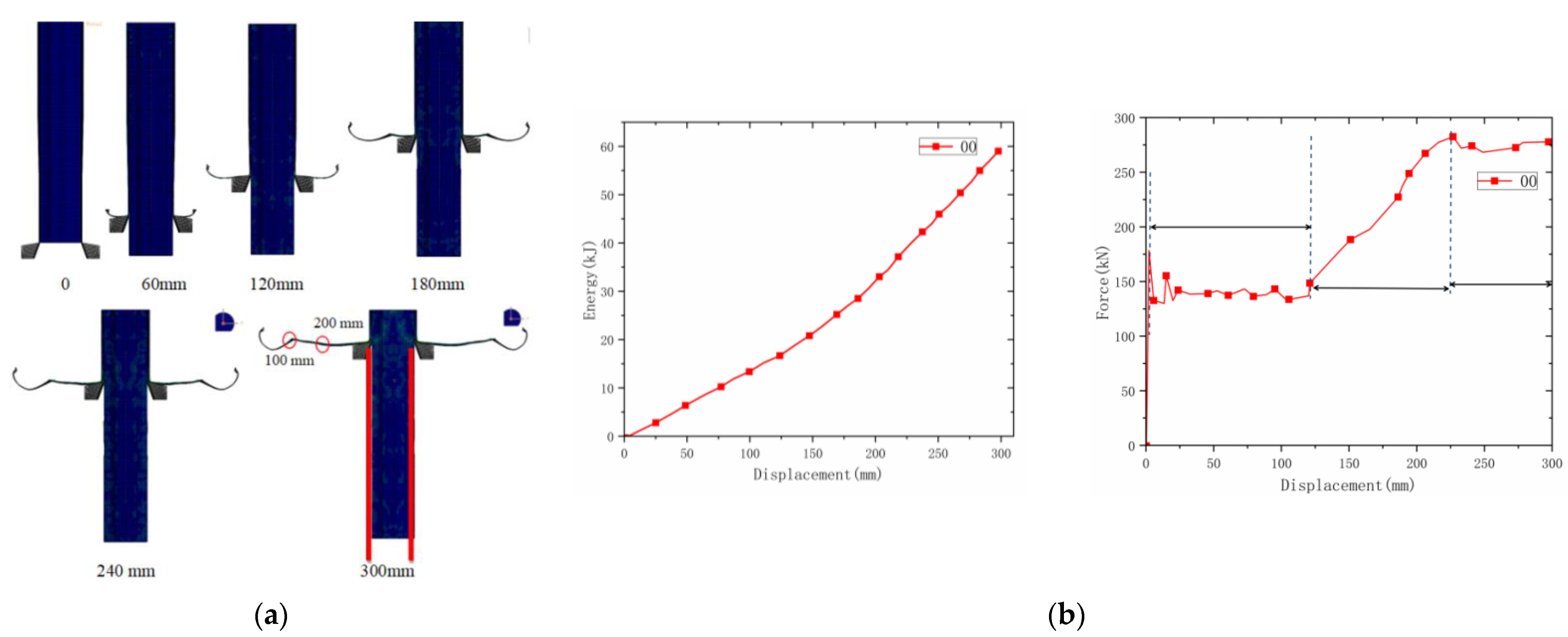

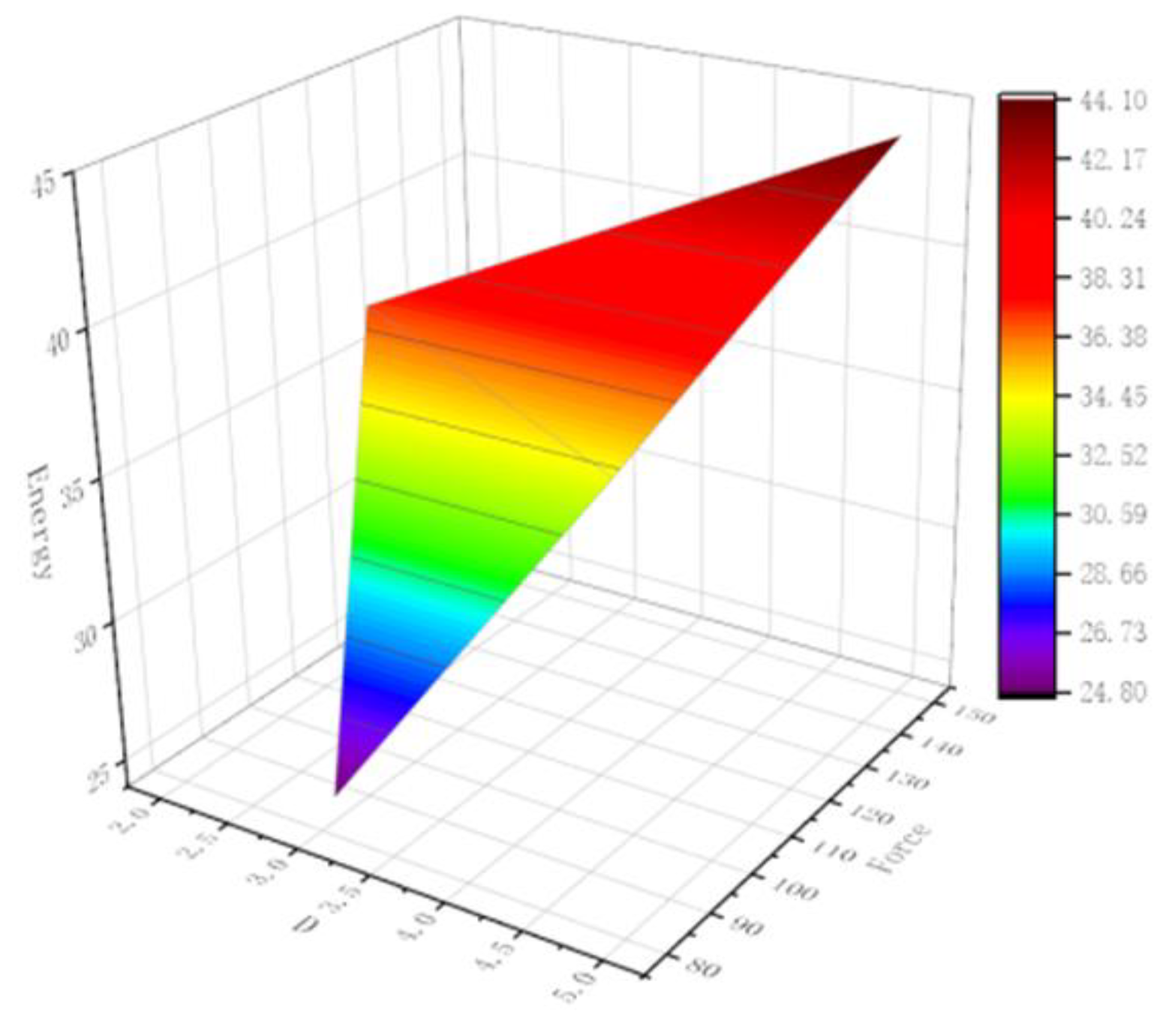
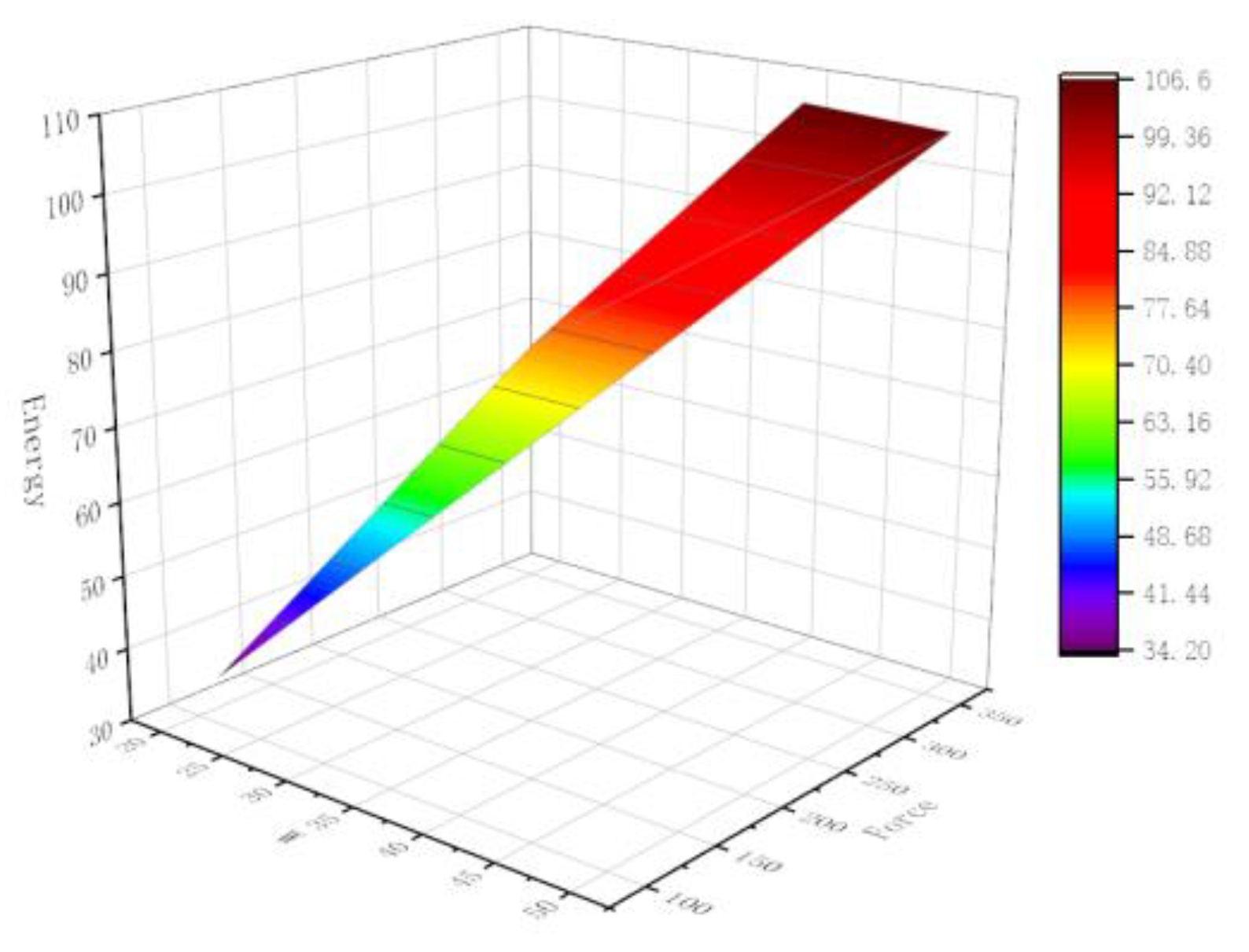
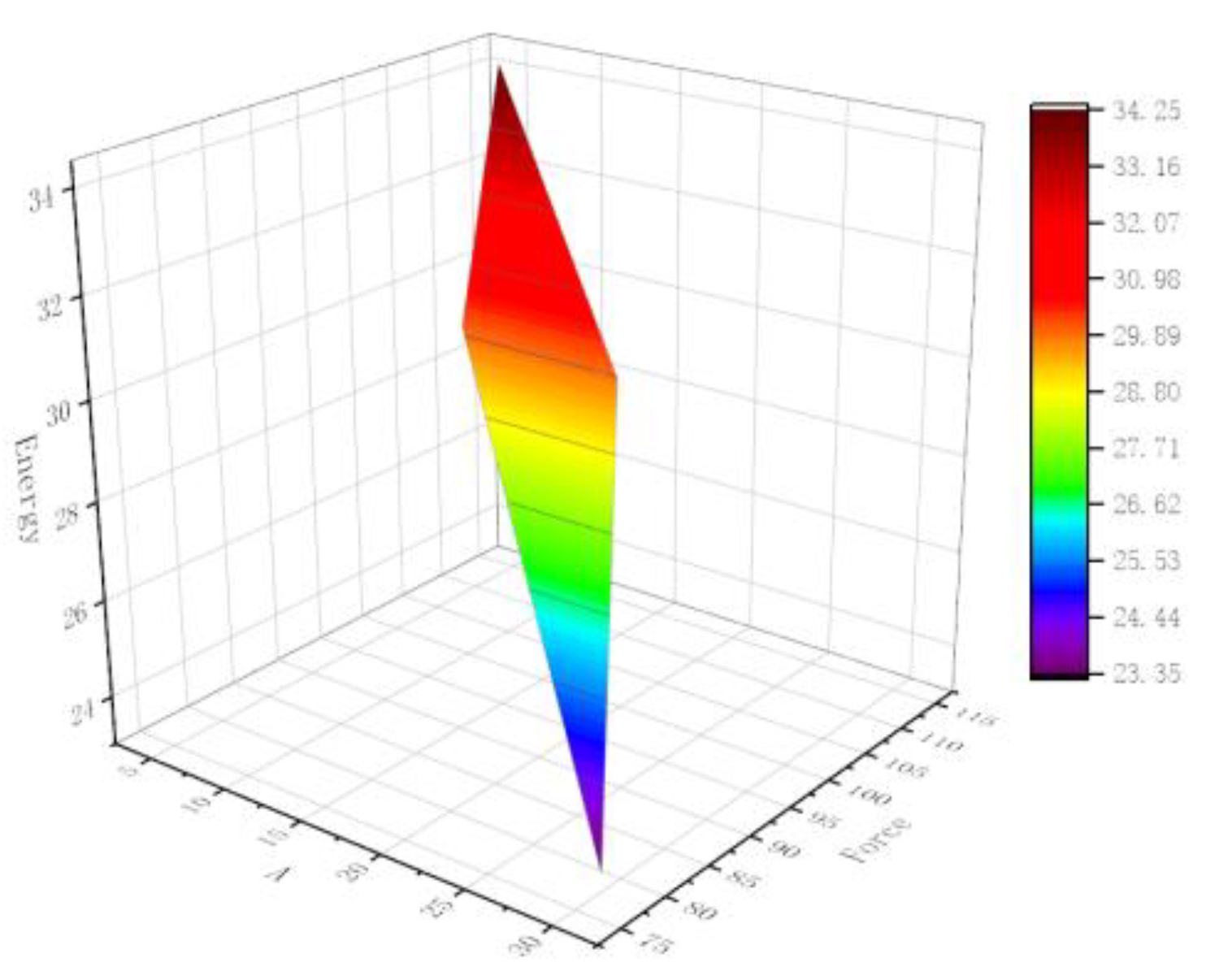
| Parameter | S1 | S2 | S3 | D1 | D2 | A | W |
|---|---|---|---|---|---|---|---|
| size | 100 mm | 100 mm | 150 mm | 2 mm | 4 mm | 10° | 30 mm |
| Number/Parameter | D1 | D2 | W | S1 | S2 | S3 | A (Rake Angle °) | Average Force (kN) | Energy (MJ) |
|---|---|---|---|---|---|---|---|---|---|
| 1.5 | 2 | 4 | 30 | 100 | 100 | 150 | 5 | 252.78 | 75.8 |
| 1.10 | 2 | 4 | 30 | 100 | 100 | 150 | 10 | 120.859 | 36.25 |
| 1.20 | 2 | 4 | 30 | 100 | 100 | 150 | 20 | 210.468 | 63.14 |
| 1.30 | 2 | 4 | 30 | 100 | 100 | 150 | 30 | 208.512 | 62.55 |
| 2.5 | 1.5 | 3 | 20 | 100 | 100 | 150 | 5 | 82.814 | 24.844 |
| 2.10 | 1.5 | 3 | 20 | 100 | 100 | 150 | 10 | 88.213 | 26.463 |
| 2.20 | 1.5 | 3 | 20 | 100 | 100 | 150 | 20 | 89.071 | 26.721 |
| 2.30 | 1.5 | 3 | 20 | 100 | 100 | 150 | 30 | 80.296 | 24.088 |
| 3.5 | 2 | 4 | 20 | 100 | 100 | 150 | 5 | 114.025 | 34.207 |
| 3.10 | 2 | 4 | 20 | 100 | 100 | 150 | 10 | 100.066 | 30.019 |
| 3.20 | 2 | 4 | 20 | 100 | 100 | 150 | 20 | 99.568 | 29.87 |
| 3.30 | 2 | 4 | 20 | 100 | 100 | 150 | 30 | 77.865 | 23.359 |
| 4.5 | 2.5 | 5 | 20 | 100 | 100 | 150 | 5 | 146.878 | 44.06 |
| 4.10 | 2.5 | 5 | 20 | 100 | 100 | 150 | 10 | 157.544 | 47.263 |
| 4.20 | 2.5 | 5 | 20 | 100 | 100 | 150 | 20 | 110.053 | 33.015 |
| 4.30 | 2.5 | 5 | 20 | 100 | 100 | 150 | 30 | 149.801 | 44.94 |
| 5.5 | 1 | 2 | 20 | 100 | 100 | 150 | 5 | 123.351 | 37.005 |
| 5.10 | 1 | 2 | 20 | 100 | 100 | 150 | 10 | 83.412 | 25.023 |
| 5.20 | 1 | 2 | 20 | 100 | 100 | 150 | 20 | 42.691 | 12.807 |
| 5.30 | 1 | 2 | 20 | 100 | 100 | 150 | 30 | 50.748 | 15.224 |
| 6.5 | 2 | 4 | 40 | 100 | 100 | 150 | 5 | 355.023 | 106.507 |
| 6.10 | 2 | 4 | 40 | 100 | 100 | 150 | 10 | 406.753 | 122.026 |
| 6.20 | 2 | 4 | 40 | 100 | 100 | 150 | 20 | 383.816 | 115.145 |
| 6.30 | 2 | 4 | 40 | 100 | 100 | 150 | 30 | 298.014 | 89.404 |
| 7.5 | 2 | 4 | 50 | 100 | 100 | 150 | 5 | 352.693 | 105.808 |
| 7.10 | 2 | 4 | 50 | 100 | 100 | 150 | 10 | 230.319 | 69.095 |
| 7.20 | 2 | 4 | 50 | 100 | 100 | 150 | 20 | 224.534 | 67.36 |
| 7.30 | 2 | 4 | 50 | 100 | 100 | 150 | 30 | 269.777 | 80.933 |
| D2/mm | W/mm | A/° | Average Force/kN | Energy Absorption/MJ |
|---|---|---|---|---|
| 2 | 20 | 5 | 123.351 | 37.005 |
| 3 | 20 | 5 | 82.841 | 24.844 |
| 4 | 20 | 5 | 114.025 | 34.207 |
| 5 | 20 | 5 | 146.878 | 44.06 |
| D2/mm | W/mm | A/° | Average Force/kN | Energy Absorption/MJ |
|---|---|---|---|---|
| 4 | 20 | 5 | 114.025 | 34.207 |
| 4 | 30 | 5 | 252.78 | 75.8 |
| 4 | 40 | 5 | 355.023 | 106.507 |
| 4 | 50 | 5 | 352.693 | 105.808 |
| D2/mm | W/mm | A/° | Average Force/kN | Energy Absorption/MJ |
|---|---|---|---|---|
| 4 | 20 | 5 | 114.025 | 34.207 |
| 4 | 20 | 10 | 100.066 | 30.019 |
| 4 | 20 | 20 | 99.568 | 29.87 |
| 4 | 20 | 30 | 77.865 | 23.359 |
Disclaimer/Publisher’s Note: The statements, opinions and data contained in all publications are solely those of the individual author(s) and contributor(s) and not of MDPI and/or the editor(s). MDPI and/or the editor(s) disclaim responsibility for any injury to people or property resulting from any ideas, methods, instructions or products referred to in the content. |
© 2023 by the authors. Licensee MDPI, Basel, Switzerland. This article is an open access article distributed under the terms and conditions of the Creative Commons Attribution (CC BY) license (https://creativecommons.org/licenses/by/4.0/).
Share and Cite
Wei, W.; Zhang, F.; Xing, Y.; Wang, H.; Liu, R. Design and Mechanical Properties Analysis of Variable Buffer-Force Planing Energy-Absorbing Device for Rail Vehicles. Appl. Sci. 2023, 13, 1596. https://doi.org/10.3390/app13031596
Wei W, Zhang F, Xing Y, Wang H, Liu R. Design and Mechanical Properties Analysis of Variable Buffer-Force Planing Energy-Absorbing Device for Rail Vehicles. Applied Sciences. 2023; 13(3):1596. https://doi.org/10.3390/app13031596
Chicago/Turabian StyleWei, Wei, Fengqiang Zhang, Youdong Xing, Hongxiang Wang, and Rongqiang Liu. 2023. "Design and Mechanical Properties Analysis of Variable Buffer-Force Planing Energy-Absorbing Device for Rail Vehicles" Applied Sciences 13, no. 3: 1596. https://doi.org/10.3390/app13031596
APA StyleWei, W., Zhang, F., Xing, Y., Wang, H., & Liu, R. (2023). Design and Mechanical Properties Analysis of Variable Buffer-Force Planing Energy-Absorbing Device for Rail Vehicles. Applied Sciences, 13(3), 1596. https://doi.org/10.3390/app13031596





